Uss Kitty Hawk to Sail Again
USS KITTY HAWK was the lead ship of the Navy�s second class of "super carriers" and the second ship in the Navy to bear the name. Initially commissioned as attack aircraft carrier CVA 63, she was redesignated as multi-purpose aircraft carrier CV 63 April 29, 1973.
Since August 1998, KITTY HAWK was homeported in Yokosuka, Japan, where she relieved the USS INDEPENDENCE (CV 62) as the only forward deployed aircraft carrier in the Navy. The KITTY HAWK left Japan for the last time in mid-2008. After participation in RIMPAC 2008, the carrier continued to San Diego, Calif., to meet the USS GEORGE WASHINGTON (CVN 73) for turn-over. The GEORGE WASHINGTON replaced the KITTY HAWK in Japan.
Decommissioned on May 12, 2009, the KITTY HAWK is now laid up at Bremerton, Wash., and is scheduled to be scrapped.
Crew List:
This section contains the names of sailors who served aboard USS KITTY HAWK. It is no official listing but contains the names of sailors who submitted their information.
History of USS KITTY HAWK:
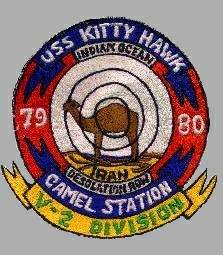
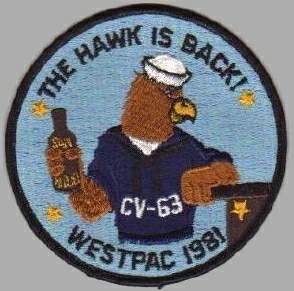 The history of USS KITTY HAWK closely parallels the course of naval aviation over the past 37 years. Built in Camden, NJ, KITTY HAWK was heralded as the first in a new class of "super carrier" at her commissioning at the Philadelphia Naval Shipyard on April 29, 1961.
The history of USS KITTY HAWK closely parallels the course of naval aviation over the past 37 years. Built in Camden, NJ, KITTY HAWK was heralded as the first in a new class of "super carrier" at her commissioning at the Philadelphia Naval Shipyard on April 29, 1961.
The 82,000-ton ship departed her homeport of San Diego on her first Western Pacific (WESTPAC) deployment in 1962. Since that time, KITTY HAWK and a variety of Carrier Air Wings have completed 18 deployments in support of operations including Vietnam, the Iranian hostage crisis, Operation Restore Hope in Somalia and air strikes against Iraq. As leader of the joint, coalition offensive strike launched in response to increasing Iraqi violations of United Nations sanctions.
KITTY HAWK underwent three overhauls in the Bremerton, Wash., Naval Shipyard in 1977, 1982 and 1998. The ship's most significant maintenance period, however, was a Service Life Extension Program (SLEP) in the Philadelphia Naval Shipyard beginning in 1987. That rigorous four-year overhaul added an estimated 20 years to the planned 30-year life of the ship. KITTY HAWK displayed the long reach of carrier aviation by completing a world cruise on the way to Philadelphia and returned by rounding the southernmost tip of South America.
The Hawk set sail on its 17th deployment on June 24, 1994. During the six-month cruise, KITTY HAWK, and Carrier Air Wing Fifteen, under the direction of the Commander, Cruiser Destroyer Group FIVE, provided a stabilizing influence in the Western Pacific during a time of great tension in the Far East.
Soon after KITTY HAWK's return from deployment, the ship was awarded the Battle Efficiency Award, or Battle "E," given yearly to the best carrier in the Pacific Fleet.
In October, KITTY HAWK welcomed aboard the proud members and imposing airpower of Carrier Air Wing Eleven, fresh off a deployment to the Persian Gulf aboard the USS ABRAHAM LINCOLN (CVN 72).
KITTY HAWK and Carrier Air Wing ELEVEN, refined their teamwork during workups, enjoying a very successful participation in Exercise Rim of the Pacific '96, a multi-national exercise taking place around the Hawaiian Islands involving the maritime forces of Canada, Japan, South Korea, Chile and Australia, in preparation for deployment in October 1996.
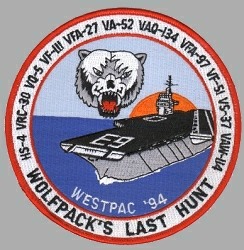
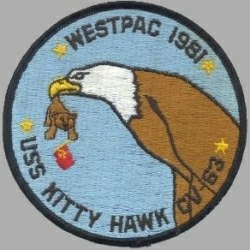 KITTY HAWK began its 18th deployment Oct. 11, 1997. En route to the Arabian Gulf, the KITTY HAWK/CVW-11 team made port calls in Hong Kong and Singapore. Christmas was celebrated inport Bahrain, and two Gulf port calls were made to Jebel Ali, U.A.E. Returning from a successful tour at the "tip of the spear", the crew enjoyed liberty in Fremantle, Australia and Hobart, Tasmania. After a brief stop in Hawaii, KITTY HAWK returned to San Diego April 11, 1997.
KITTY HAWK began its 18th deployment Oct. 11, 1997. En route to the Arabian Gulf, the KITTY HAWK/CVW-11 team made port calls in Hong Kong and Singapore. Christmas was celebrated inport Bahrain, and two Gulf port calls were made to Jebel Ali, U.A.E. Returning from a successful tour at the "tip of the spear", the crew enjoyed liberty in Fremantle, Australia and Hobart, Tasmania. After a brief stop in Hawaii, KITTY HAWK returned to San Diego April 11, 1997.
In August 1998, KITTY HAWK changed its homeport from San Diego, Calif., to Yokosuka in Japan and relieved the USS INDEPENDENCE (CV 62) as the only carrier forward deployed to another country.
On March 2, 1999, KITTY HAWK departed Yokosuka on a three-and-a-half month deployment to the Arabian Gulf where she operated in support of Operation Southern Watch.
Before entering the Indian Ocean she participated in Exercise Tandem Thrust in the Pacific, during which the former USS OKLAHOMA CITY (CLG 5) was being used as a target. After the exercise, KITTY HAWK visited Apra Harbor, Guam, on April 3, 1999, before departing for the Persian Gulf where she patrolled the No-Fly-Zone over southern Iraq.
KITTY HAWK departed the Gulf on July 15, 1999, and returned to Yokosuka where she arrived on August 25, 1999.
The year 2000 saw KITTY HAWK and her Battle Group operating in the western Pacific. The carrier took part in Exercise Cobra Gold 2000 and conducted port visits to Phattaya, Thailand; Hong Kong and Singapore
After the terrorist attacks in New York City and Washington, DC, on September 11, 2001, the KITTY HAWK Battle Group was ordered to deploy to the Indian Ocean and was later involved in combat missions against the Taliban and Al Qaida in Afghanistan. The Battle Group returned to Yokosuka on December 23, 2001.
On March 21, 2002, KITTY HAWK became the first carrier in the US Navy to perform test firings with the
On October 25, 2002, the KITTY HAWK Battle Group left Yokosuka for a regular scheduled underway period. After a port visit to Hong Kong November 29 through December 3, the Battle Group returned to Japan on December 13.
The ships got underway again late January with orders to deploy to the Persian Gulf as part of the build-up of military forces in the area in preparation for the war against the regime of Saddam Hussein in Iraq. KITTY HAWK arrived on station late February/early March and from March 20 on, participated in air strikes against targets in Iraq as part of Operation Iraqi Freedom. After serving 104 continuous days at sea, KITTY HAWK returned to Yokosuka May 6, entering a dry-dock period ending Oct. 17.
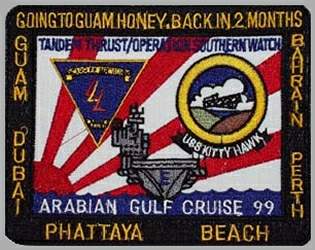
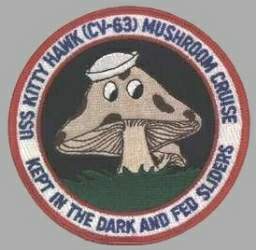 2004 was an eventful year that involved a series of inspections, exercises, and port visits. On Feb. 19, a new chapter in the book of KITTY HAWK Strike Group�s history began with the first landing of an F/A-18F Super Hornet on board KITTY HAWK�s 4.1-acre flight deck during the ship�s 12th FDNF underway period. The VFA-102 �Diamondbacks� introduced the improved F/A-18 E/F �Super Hornet� to the 7th Fleet area of operation, replacing the F-14 Tomcat, after more than 30 years of service.
2004 was an eventful year that involved a series of inspections, exercises, and port visits. On Feb. 19, a new chapter in the book of KITTY HAWK Strike Group�s history began with the first landing of an F/A-18F Super Hornet on board KITTY HAWK�s 4.1-acre flight deck during the ship�s 12th FDNF underway period. The VFA-102 �Diamondbacks� introduced the improved F/A-18 E/F �Super Hornet� to the 7th Fleet area of operation, replacing the F-14 Tomcat, after more than 30 years of service.
KITTY HAWK capped off the year with Annual Exercise 2005, which ran from November 9 to 18. ANNUALEX provided KITTY HAWK with the opportunity to increase its military partnership with the Japan Maritime Self-Defense Force. KITTY HAWK was one of 61 naval vessels which participated, including: two U.S. submarines; 10 other Navy ships; and 49 JMSDF ships.
The ship departed Fleet Activities Yokosuka, June 8, 2006, for its 16th FDNF underway period. During the 99-day deployment, the ship took part in Exercise Valiant Shield, a multi-service war game involving three carrier strike groups, 22,000 personnel, and 280 aircraft June 19 to 23. It was the largest military exercise conducted by the United States in Pacific waters since the Vietnam War.
The carrier then pulled into Otaru, Japan, on Hokkaido Island from July 1 to 5 after Valiant Shield. Also during the deployment, the crew made three more port visits: Singapore; Fremantle, Australia; and Laem Chabang, Thailand. Dozens of distinguished visitors boarded the carrier during this underway period for tours. Visitors included the U.S. ambassador to Thailand, the Royal Thai army commander in chief, and various officials from Indonesia, Australia, Singapore, and Japan. The ship returned to Yokosuka September for a short period before departing for its summer deployment.
During this two-month deployment, KITTY HAWK and embarked Carrier Air Wing 5 traveled more than 15,200 nautical miles and launched more than 8,000 aircraft. After a stop in Sasebo, Japan, the strike group took part in the 18th Annual Exercise, a week-long exercise which had more than 100 American and JMSDF ships training together, between November 9 and 14. The deployment�s last stop was Hong Kong, from November 23 to 27. KITTY HAWK�s Morale, Welfare and Recreation (MWR) Division organized 20 tours of Hong Kong and its surrounding areas, including mainland China, for 702 Sailors. The ship also hosted Japanese author Hiromi Nakamura who interviewed 41 KITTY HAWK Sailors for a book about KITTY HAWK�s flight deck. After returning to its homeport on December 10, the ship settled down for the holiday season and the New Year.
KITTY HAWK then went through a four-month maintenance period, during which the ship hosted Vice President Dick Cheney.
The carrier then departed May 23, 2007, after completing sea trials and pilot refresher training, known as carrier qualifications. KITTY HAWK kicked off the summer cruise with Talisman Saber 2007, in which the United States and Australia combined land, sea and air forces. The exercise brought together more than 12,000 Australian and 20,000 U.S. personnel from all branches of the armed services. The ship made port visits to Brisbane and Sydney, Australia. Then-Prime Minister John Howard and current Prime Minister Kevin Rudd and Academy Award Winning Actor Russell Crowe made visits to Kitty Hawk while it was moored in Sydney.
KITTY HAWK then participated in Exercise Valiant Shield 2007, one of the largest annual exercises in the Western Pacific. The week-long exercise involved about 30 ships, 280 aircraft and 22,000 U.S. Airmen, Sailors, Soldiers and Marines who worked together to build joint combat skills. The 30 ships involved with Valiant Shield were from three carrier strike groups: KITTY HAWK�s, USS NIMITZ�s (CVN 68) and USS JOHN C. STENNIS�s (CVN 74). During the exercise, Rear Adm. Rick Wren, commander of the KITTY HAWK strike group and Task Force 70, had command of all three strike groups.
The ship also took part in Malabar, a six-day exercise that took place in the Indian Ocean�s Bay of Bengal, involving more than 20,000 personnel on 28 ships and 150 aircraft from the United States Navy, Indian navy, Royal Australian navy, Japan Maritime Self-Defense Force, and the Republic of Singapore navy. The ship returned to Yokosuka September 21. After a short in-port period, KITTY HAWK set out for its final fall deployment October 21, 2007.
KITTY HAWK participated in the 19th Annual Exercise, the maritime component of Exercise Keen Sword 2008. The exercise was the largest joint exercise for the Navy and Japan Maritime Self-Defense Force. KITTY HAWK also had a port visit in Muroran, Japan. This was the first time a U.S. Navy ship made a visit to the port.
The carrier pulled to its homeport November 27 after 38 days at sea. KITTY HAWK stayed in port for a 5-month maintenance period before setting out to complete sea trials and carrier qualifications.
On May 28, 2008, the KITTY HAWK left Yokosuka for the last time enroute to Guam and continued on to Pearl Harbor, Hi., to participate in RIMPAC 2008. Before heading out to Puget Sound Naval Shipyard in Bremerton, Washington, for decommissioning in May 2009, the ship stopped in Pearl Harbor, Hawaii, to turnover with the USS GEORGE WASHINGTON (CVN 73) and thereafter continued to San Diego, Calif.
The fire caused heavy damage aboard the ship, killed some crewmen, and injured 48 others.
At the time of the collision, the USS KITTY HAWK was carrying up to several dozen nuclear weapons, and the Soviet submarine probably carried two nuclear torpedoes.
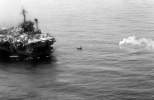
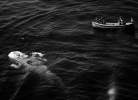
Click here to watch a clip of the accident. .mpg file, 420 KB
Click here to watch a clip of the accident. .mpg file, 6.8 MB
The two photos below were taken by Karl-Heinz Ahles and show USS KITTY HAWK at Naval Air Station North Island, San Diego, Ca., in October 1997.
The photos below were taken by Ian Johnson and show the USS KITTY HAWK departing Fremantle, Australia, on April 27, 2004. This port visit was KITTY HAWK's fifth visit to Western Australia.
The photos below were taken by Ian Johnson and show the USS KITTY HAWK at Fremantle, Australia, on August 10, 2006. This port visit was KITTY HAWK's last visit to Western Australia.
The photos below were taken by me and show the KITTY HAWK laid-up at the Puget Sound Naval Shipyard, Bremerton, Wash., on March 14, 2010.
The photos below were taken by me and show the KITTY HAWK laid-up at the Puget Sound Naval Shipyard, Bremerton, Wash., on May 12, 2012.
The photos below were taken by Michael Jenning and show the KITTY HAWK laid-up at the Puget Sound Naval Shipyard, Bremerton, Wash., on April 17, 2016.
The photos below were taken by Michael Jenning and show the KITTY HAWK laid-up at the Puget Sound Naval Shipyard, Bremerton, Wash., on October 13, 2017.
The photos below were taken by Sebastian Thoma and show the KITTY HAWK laid-up at the Puget Sound Naval Shipyard, Bremerton, Wash., on May 15, 2018.
Source: https://www.navysite.de/cvn/cv63.htm
0 Response to "Uss Kitty Hawk to Sail Again"
Post a Comment